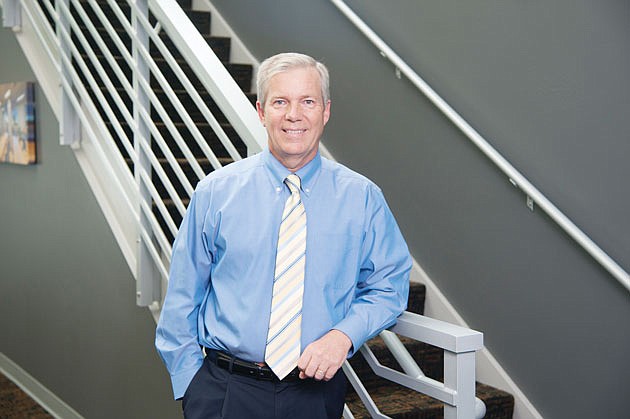- November 22, 2024
-
-
Loading

Loading

The impact of the construction industry's labor shortage recently hit Willis A. Smith Construction in an unusual way.
It wasn't on a job, coming up short on the production side. Instead, it happened with an executive recruiter. The Sarasota-based company hired the recruiter to help it find a new senior level project manager. The recruiter found a good candidate, says Willis Smith President and CEO David Sessions. Then the recruiter promptly turned around and tried to poach one of Willis Smith's executives for a rival construction firm.
The story illustrates not only the murky ethics of the executive recruiter. It's also another example of how hot the construction market is, now going on five years in recovery mode. At Willis Smith, the industry rebound has the company on the verge of a major milestone: $100 million in annual revenue. “There's a lot more need for construction services than there has been in a long while,” Sessions says.
Sessions projects Willis Smith will hit the $100 million figure this year — more than double the $43.3 million it posted in 2011, at the depths of the downturn. The firm had $85.4 million in revenue in 2016, up 18.2% from $72.2 million in 2014. It has around 80 employees.
The $100 million mark is not only an accomplishment for Willis Smith. It's also notable in the consolidated Sarasota-Manatee construction industry, where there are few locally based builders with that kind of size. Sarasota-based Kellogg & Kimsey is one, with $80 million in sales in 2016. And University Park-based Core Construction had $110 million in revenue last year.
While Sessions, who has been with the firm since 1988, nods with pride over the milestone, he says he realizes market forces are partly responsible for the boost. “This company has never had a revenue goal,” says Sessions. “Our focus is more on taking care of our customers. We want to focus on what we're really good at.”
The revenue figure also crystallizes Session's biggest up-at-night worry — a market correction is forthcoming.
“We are in what I would call an overheated market,” says Sessions. “I would like to see things be more steady. I'm not a pessimistic person, but I don't have a sense of optimism that things are always going to go up and up.”
Sessions speaks not only from logic that the market will turn at some point, but also experience. Revenue rose 276%, for example, from $15.4 million in 2002 to $57.9 million in 2004. A robust market, just like doing now, helped push the rise. Sessions and other Willis Smith executives also began to revamp the company's strategy in the early 2000s, to go from mostly doing public work to a broader mix of public and private projects.
“We will get into another valley,” Sessions says. “No one can perfectly predict when it will happen, but we will get into another valley.”
Willis Smith hit another milestone in 2017, celebrating its 45th anniversary. When founder Willis A. Smith launched the business, the focus was mostly building commercial and industrial facilities. One of the keys in the early days was the firm tried to remain conservative in the jobs it took, and not take on too much at any one time. “We will continue to choose our clients and projects carefully,” says Sessions. “We won't pursue any projects where we don't have the right people and capacity.”
The Willis Smith project list includes the K-12 and higher education market; churches; governments and municipal organizations; hospitals and medical facilities; and assorted other sectors. Clients over the years have included PGT Innovations and drinkware manufacturer Tervis, two of the largest employers in the region. Willis Smith has also done work for Mote Marine Laboratory, Ringling College of Art and Design and the Sarasota Opera House.
Willis Smith has been lauded, in the community and construction industry, for its work for clients. Yet one of its most notable projects of the past decade is something it did for itself, its own headquarters, in a Lakewood Ranch corporate park. The company built the 18,000-square-foot complex in 2008, a nearly $4 million project in the onset of the recession.
The project was a true green build, incorporating multiple environmentally friendly and sustainable features. That included windows made with two pieces of low-emission glass with dead air in between that reflect light back to the source and a cool roof system with solar photovoltaic panels.
The goal was to not only go green, but also use the experience as a test tube for clients. Today, the Willis Smith building is off the electrical grid, courtesy of the solar panels, while the roof collects rainwater for landscape irrigation and toilet flushing. The features added about 7% to the overall cost of construction, which Sessions says been more than made up for in the past nine years.
Another aspect of the company, says Sessions, is its efforts in retention and employee morale. There's a team of senior leaders who are ready, eventually, to take over for Sessions and Vice President John LaCivita. And there's another team of up-and-comers behind those leaders.
Sessions says the company pays well, and offers good benefits, but its retention success stems more from intangibles. “We give people a lot of responsibility,” Sessions says. “We empower people to make decisions. I think that causes a lot of people to like their jobs here.”